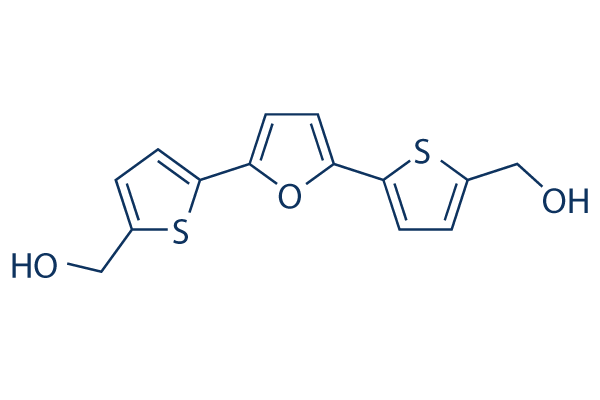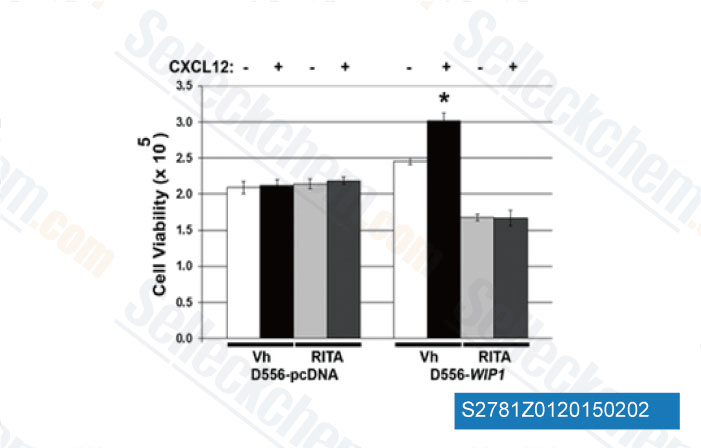|
受注:045-509-1970 |
技術サポート:tech@selleck.co.jp 平日9:00〜18:00 1営業日以内にご連絡を差し上げます |
化学情報

|
Synonyms | NSC 652287 | Storage (From the date of receipt) |
3 years -20°C powder 1 years -80°C in solvent |
|||||||||||
| 化学式 | C14H12O3S2 |
||||||||||||||
| 分子量 | 292.37 | CAS No. | 213261-59-7 | ||||||||||||
| Solubility (25°C)* | 体外 | DMSO | 58 mg/mL (198.37 mM) | ||||||||||||
| Ethanol | 8 mg/mL (27.36 mM) | ||||||||||||||
| Water | Insoluble | ||||||||||||||
| 体内 (毎回新しく調製した物を用意してください) |
|
||||||||||||||
|
* <1 mg/ml means slightly soluble or insoluble. * Please note that Selleck tests the solubility of all compounds in-house, and the actual solubility may differ slightly from published values. This is normal and is due to slight batch-to-batch variations. |
|||||||||||||||
溶剤液(一定の濃度)を調合する
生物活性
| 製品説明 | RITA induces both DNA-protein and DNA-DNA cross-links with no detectable DNA single-strand breaks, and also inhibits MDM2-p53 interaction by targeting p53. |
|---|---|
| in vitro | RITA shows a highly selective pattern of differential cytotoxic activity in the tumor cell lines, due to cellular accumulation to the cytosolic (S100) fraction. This compound also inhibits the growth of other renal cell lines including ACHN and UO-31 with IC50 of 13 μM and 37 μM, respectively. [1] It (10 nM) causes cell cycle arrest with accumulation of cells at the G2-M phase and induces DNA fragmentation and apoptosis at 100 nM, both with evaluated p53 protein levels. This chemical (30 nM) also induces both DNA-protein and DNA-DNA cross-links in A498 cells. Meanwhile it has no effects on top1-mediated relaxation of supercoiled SV40 DNA. [2] It significantly suppresses the growth of HCT116 cells (97%) but only slightly inhibits the growth of HCT116 TP53-/- cells (13%). This compound is much more efficient at growth suppression in wild-type p53-expressing tumor cell lines than in cell lines lacking p53 and those expressing mutant p53. It binds full-length p53 but not glutathione S-transferase (GST) protein or HDM-2 (a key regulator of p53 is strongly supported by the rescue of embryonic lethality of MDM2). This chemical blocks p53−HDM-2 interaction and p53 ubiquitination. It substantially decreases the amount of HDM-2 that is co-precipitated with p53, although both proteins are upregulated. This compound prevents interactions between the purified GST-p53 and 6XHis-tagged His-HDM-2 proteins. [3] It is shown to induce apoptosis by promoting p53Ser46 phosphorylation. [4] This chemical induces activation of p53 in conjunction with up-regulation of phosphorylated ASK-1, MKK-4 and c-Jun. It induces the activation of JNK signaling. [5] But On the contrary, another results by nuclear magnetic resonance (NMR) show that it does not block the formation of the complex between p53 (residues 1-312) and the N-terminal p53-binding domain of MDM2 (residues 1-118), which is highly probable that the binding of this compound requires native conformation of p53. [6] |
| in vivo | RITA is well tolerated in mice after intraperitoneal administration, with no observable weight loss at doses up to 10 mg/kg during 1 month. After five injections of 0.1 mg/kg of this compound, the growth of the HCT116 tumors is suppressed by 40%, without apparent effects on the HCT116 TP53-/- tumors. At a dose of 1 or 10 mg/kg, it shows strong antitumor activity. Five 1 mg/kg injections of this chemical results in a more than twofold decrease in the growth rate of p53-positive xenografts without any effect on p53-null xenografts. HCT116 tumors are 90% smaller in mice treated with 10 mg/kg of it than in control untreated mice. This compound inhibits the tumor growth in a wild-type p53−dependent manner. [3] |
| 特徴 | Inducer of DNA cross-links, not a DNA intercalator. |
プロトコル(参考用のみ)
| 細胞アッセイ | 細胞株 | HCT116 cells and HCT116 TP53-/- cells |
|---|---|---|
| 濃度 | 0.1 nM - 1 mM, 10 mM stocked in DMSO | |
| 反応時間 | 48 hours | |
| 実験の流れ | Examination to assess susceptibility of cells to RITA (0.1 nM - 1 mM) is done using the XTT assay. Cells are inoculated into 96-well flat-bottom plates at a density of 1500 cells per well and incubated for 24 hours at 37 °C in a humidified 5% CO2 5% air atmosphere. Serial concentrations of this compound in DMSO are added to the wells, and sensitivity is determined 48 hours after the addition of this chemical. | |
| 動物実験 | 動物モデル | SCID mice carrying HCT116 and HCT116 TP53-/- xenografts |
| 投薬量 | 0.1 mg/kg, 1 mg/kg or 10 mg/kg | |
| 投与方法 | Administered via i.v. or i.p. |
参考
|
カスタマーフィードバック

-
Data from [Data independently produced by Oncogene, 2014, 10.1038/onc.2014.37]
Selleckの高級品が、幾つかの出版された研究調査結果(以下を含む)で使われた:
| Tert promotes cardiac regenerative repair after MI through alleviating ROS-induced DNA damage response in cardiomyocyte [ Cell Death Discov, 2024, 10(1):381] | PubMed: 39187478 |
| Tripartite motif containing 69 elicits ERK2-dependent EYA4 turnover to impart pancreatic tumorigenesis [ J Cancer, 2023, 14(2):200-218] | PubMed: 36741265 |
| Wnt4 is crucial for cardiac repair by regulating mesenchymal-endothelial transition via the phospho-JNK/JNK [ Theranostics, 2022, 12(9):4110-4126] | PubMed: 35673578 |
| Mild oxidative stress protects against chemotherapy-induced hair loss [ Front Oncol, 2022, 12:1078916] | PubMed: 36703797 |
| Tubule-specific deletion of LincRNA-p21ameliorates lipotoxic kidney injury [ Mol Ther Nucleic Acids, 2021, 26:1280-1290] | PubMed: 34853727 |
| Arsenic Trioxide Rescues Structural p53 Mutations through a Cryptic Allosteric Site [ Cancer Cell, 2020, S1535-6108(20)30605-X] | PubMed: 33357454 |
| The Meningioma Enhancer Landscape Delineates Novel Subgroups and Drives Druggable Dependencies [ Cancer Discov, 2020, CD-20-0160] | PubMed: 32703768 |
| A Human Organoid Model of Aggressive Hepatoblastoma for Disease Modeling and Drug Testing [ Cancers (Basel), 2020, 12(9)E2668] | PubMed: 32962010 |
| Wild-Type p53 Promotes Cancer Metabolic Switch by Inducing PUMA-Dependent Suppression of Oxidative Phosphorylation [ Cancer Cell, 2019, 35(2):191-203] | PubMed: 30712844 |
| Angiopoietin-like protein 3 blocks nuclear import of FAK and contributes to sorafenib response. [ Br J Cancer, 2018, 119(4):450-461] | PubMed: 30033448 |
長期の保管のために-20°Cの下で製品を保ってください。
人間や獣医の診断であるか治療的な使用のためにでない。
各々の製品のための特定の保管と取扱い情報は、製品データシートの上で示されます。大部分のSelleck製品は、推薦された状況の下で安定です。製品は、推薦された保管温度と異なる温度で、時々出荷されます。長期の保管のために必要とされてそれと異なる温度で、多くの製品は、短期もので安定です。品質を維持するが、夜通しの積荷のために最も経済的な貯蔵状況を用いてあなたの送料を保存する状況の下に、製品が出荷されることを、我々は確実とします。製品の受領と同時に、製品データシートの上で貯蔵推薦に従ってください。
